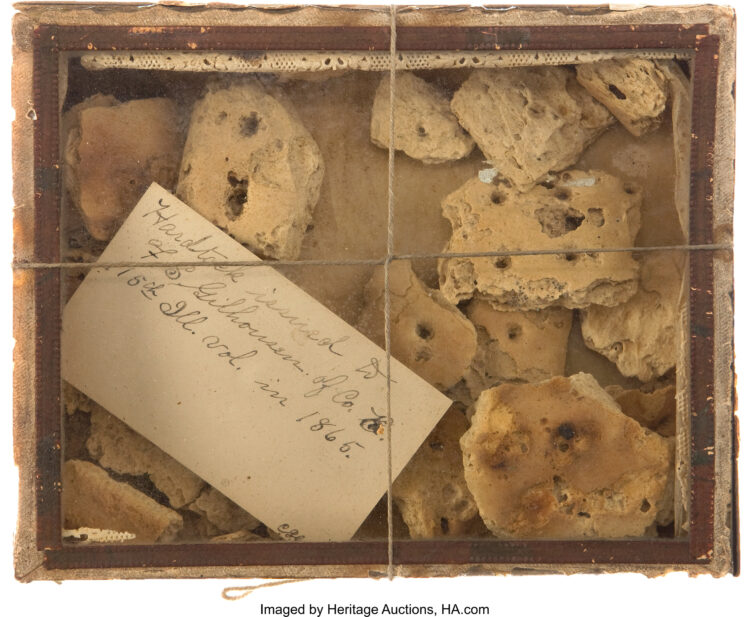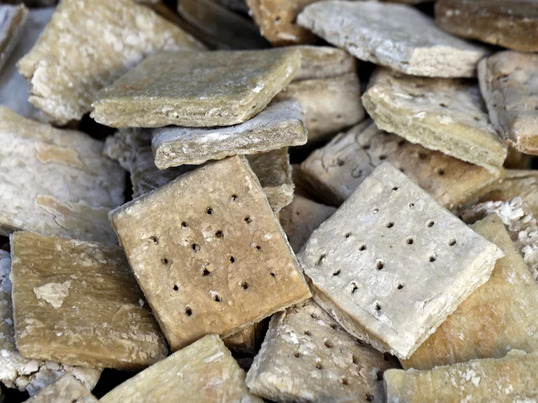Hardtack was made to last — not to taste good. Here’s a re-created ration at Bushey Farm in Gettysburg, Pa.
Matt Rourke/AP
We grab our plates and cups, and wait for no second invitation. We each get a piece of meat and a potato, a chunk of bread and a cup of coffee with a spoonful of brown sugar in it. Milk and butter we buy, or go without. We settle down, generally in groups, and the meal is soon over… We save a piece of bread for the last, with which we wipe up everything, and then eat the dish rag. Dinner and breakfast are alike, only sometimes the meat and potatoes are cut up and cooked together, which makes a really delicious stew. Supper is the same, minus the meat and potatoes.
– Lawrence VanAlstyne, Union Soldier, 128th New York Volunteer Infantry
During the American Civil War, Union soldiers faced significant challenges when it came to food. The conditions of war, long marches, limited resources, and the difficulty of supply lines meant that the diet of Union soldiers was often basic, monotonous, and lacking in variety. Here are some common food items that Union soldiers ate during the Civil War:
Salt pork was a common protein source for soldiers. It was preserved with salt, making it last longer without refrigeration. Soldiers would typically fry or boil the salt pork to make it more palatable.
Coffee was highly valued by Union soldiers and became a significant part of their diet. It provided much-needed caffeine for energy and warmth during cold nights. Soldiers often received coffee beans, and they would grind them and brew the coffee over campfires.
Canned goods, such as canned vegetables and fruits, were occasionally included in the soldiers’ rations. However, they were not as readily available as other items due to transportation difficulties.
Beans and rice were relatively common in the soldiers’ rations, providing a source of carbohydrates and protein.
When possible, soldiers would forage for wild edibles like wild onions, berries, and greens. However, access to fresh vegetables was limited, and scurvy became a problem for some troops due to the lack of vitamin C in their diets.
Soldiers would sometimes cook meat, beans, and vegetables together to create a stew-like dish, adding flavor to their rations.
In dire situations, soldiers might forage for food in the local area, gathering fruits, nuts, and whatever else they could find.
Hardtack, also known as “hardtack biscuits” or “army crackers,” was a staple food for Union soldiers. These hard, dry crackers were made from flour, water, and salt, and they were designed to have a long shelf life. Although hardtack was durable and could last for months, it was often infested with bugs and had to be soaked or cooked to make it edible. Hardtack was a type of unleavened bread that had a long shelf life and could withstand the harsh conditions of military campaigns.
Hardtack was made from a simple mixture of flour, water, and salt. The dough was rolled out and cut into small, flat, and dense squares or rectangles. The lack of leavening agents like yeast or baking soda contributed to its hard and dry texture.
Hardtack’s primary advantage was its ability to last for extended periods without spoiling. This made it a reliable source of sustenance for soldiers on long marches or when regular food supplies were scarce.
Hardtack was typically packed in wooden crates or barrels for transportation and storage. To further extend its shelf life, the crackers were often baked until they were thoroughly dried, reducing the moisture content and preventing mold growth.

While hardtack provided some calories and carbohydrates, it lacked essential nutrients and vitamins. It was also low in fat and protein, making it an insufficient source of nutrition for prolonged periods.
To make hardtack edible, soldiers would often soak the biscuits in water, coffee, or broth to soften them. Some soldiers would crumble hardtack into stews or soups to add texture and calories.
Soldiers often complained about the taste and texture of hardtack, nicknaming it various names, including “tooth-dullers,” “worm castles,” and “sheet iron crackers.”
Hardtack was a standard component of the soldiers’ ration packs, serving as a backup or emergency food source when other provisions were not available or ran out.
Due to the lack of nutrients and the presence of insects in poorly stored hardtack, it could cause digestive issues and lead to gastrointestinal problems for soldiers.
Overall, hardtack was a symbol of the hardships endured by Civil War soldiers, representing the challenges they faced in securing sufficient and nutritious food during their military service. Despite its drawbacks, hardtack played a crucial role in providing sustenance and energy to soldiers in the absence of more diverse and perishable food options on the battlefield.
Hardtack Recipe
Ingredients:
4 cups flour
2 teaspoons salt
1 cup of water (Add more or less as needed, up to another ½ cup.)
Directions:
- Preheat oven to 350 degrees.
- Mix ingredients in a bowl until they form a stiff, elastic dough but not dry or sticky. You may need to adjust the amount of water- so be careful as you add it!
- Spread the dough about ½ inch thick onto a greased cookie sheet.
- Bake for 30 minutes. Pull out of oven and let cool for 5 minutes.
- With a bread knife or pizza cutter, divide the dough into 3×3 squares and poke a grid of holes with a cleaned nail, toothpick, or skewer. Flip pieces over. Be careful with this step!
- Bake in oven for more 30 minutes or until lightly brown. Turn off the oven, leaving the hardtack inside until it cools.
Source
https://www.npr.org/sections/thesalt/2013/07/02/198042487/civil-war-soldiers-needed-bravery-to-face-the-foe-and-the-food
http://www.civilwar.com/history/soldier-life-85851/148553-soldier-s-food-during-the-civil-war.html


